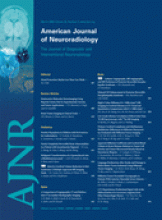We appreciate the interest and comments regarding our article.1 In it, we reported the successful visualization of the optic radiations in 20 of the 24 hemispheres by diffusion tensor (DT) tractography. However, we did not evaluate the visualization of the variations of the anterior limit of the Meyer loop in this article because we aimed to evaluate the difference in visualization of the optic radiation due to the number of motion-probing gradients and because the anterior limit of the Meyer loop was beyond the scope of the article.
As mentioned by the authors, the anterior limit of the Meyer loop is important for anterior temporal lobe (ATL) resections, and we were also aware of the anatomic variations of the Meyer loop.2 We agree with the suggestion by the authors that evaluation of intersubject variability in the anterior limit of the Meyer loop is beneficial for ATL resection. However, it is challenging for DT tractography because of its acutely curved course around the anterior limit, as we stated in our article,1 and the crossing-fiber problem.3
DT tractography has some limits, which come from its technical aspects; however, it is currently the only method to evaluate the structures of the neuronal trajectories in vivo.4 Validation of DT tractography data with results of surgical resection may reinforce its limits and the feasibility of this technique.
DT tractography has been applied in preoperative planning for cranial surgery near eloquent areas, including temporal lobe surgery.5 Regarding the crossing-fiber problem, several approaches, such as multitensor tractography,3 are going to be developed. Therefore, we believe that DT tractography is a promising technique that will more constantly visualize the full trajectory of the optic radiation in the near future.
References
- Copyright © American Society of Neuroradiology












